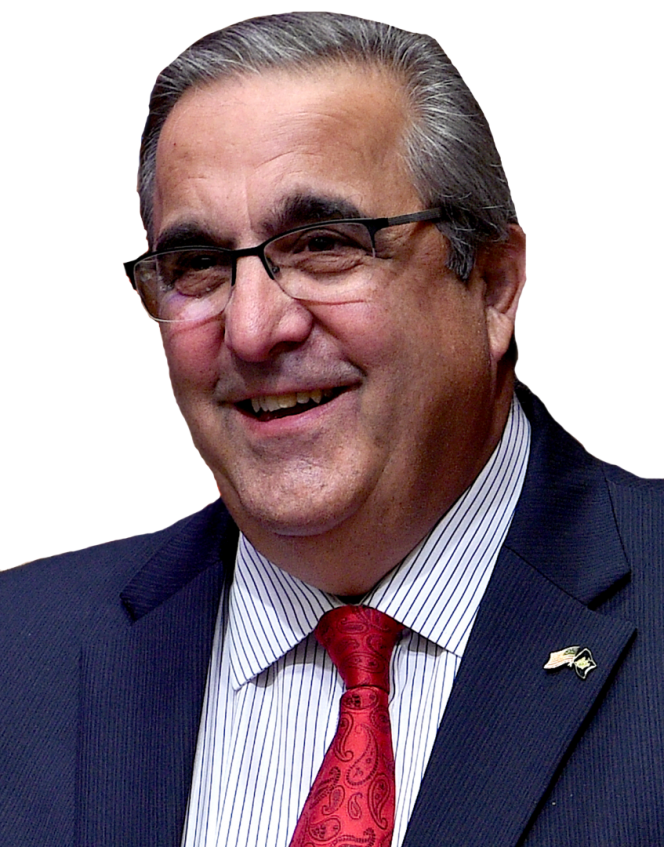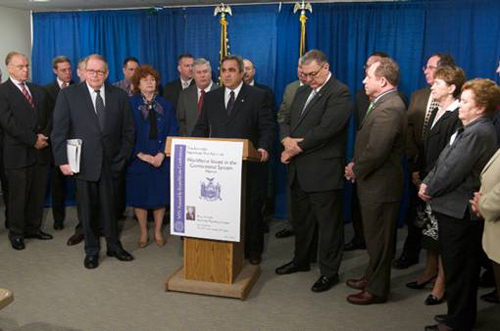Giglio and Colleagues Present Findings of Task Force on Workforce Issues in New York’s Correctional System
Assemblyman Joe Giglio (R,I,C-Gowanda) today joined Assembly Minority Leader Brian M. Kolb (R,I,C-Canandaigua), his Assembly colleagues, and Chris Leo, Legislative Director of New York State Correctional Officers & Police Benevolent Association, Inc. (NYSCOPBA), at a press conference presenting the findings of their Task Force on Issues in New York’s Correctional System. The report offers solutions to safety, administrative and fiscal problems in the state’s prisons and prison system.
“The ultimate goal of this task force is the creation and implementation of comprehensive legislative initiatives and administrative policies that will keep the state’s correctional facilities safe and secure,” said Giglio, who is the ranking Minority Member on the Assembly Correction Committee and co-chair of the Task Force on Issues in New York’s Correctional System. “All of this, while ensuring that the Department of Correctional Services utilizes taxpayer dollars and state resources in the best manner possible.”
The task force heard testimony from professionals and civilian employees who keep correctional facilities across the state safe and secure. The report highlights the safety, administrative and fiscal concerns raised during 10 task force forums held throughout the state, and outlines several specific recommendations designed to save taxpayer dollars and maintain safety in New York’s prisons.
Key findings of the report include the following:
- The Department of Correctional Services has changed the way it reports “percentage of occupancy data,” maintained unsafe inmate-to-staff ratios, allowed the double-bunking of inmates, failed to maintain the required number of Crisis Intervention Personnel, and downgraded certain violent incidents by not reporting them as assaults;
- Maintaining prison capacities below 100 percent, ensuring proper staffing ratios, eliminating double-bunking, and keeping the number of Crisis Intervention Personnel at appropriate levels will reduce serious injuries occurring in state prisons;
- The New York State Commission of Correction should initiate a study to determine the most accurate way of reporting prison capacity statistics, review the current practice of counting temporary, infirmary and special housing unit beds as permanent beds, and establish appropriate inmate-to-officer staffing ratios that will reduce prison violence and the number of “Unusual Incidents”;
- Additionally, the study should verify the necessity of administrative positions based in Albany, evaluate which services and programs the Hubs can administer, determine the scope of responsibilities for each administrator and closely examine state-funded housing and other public benefits allegedly given to superintendents and administrators; and
- Creates the “North Star Initiative,” a plan to save communities from the impact caused by the departure of a state entity from a region. It would require a reasonable three-year reuse plan to be implemented at the time of an entity closure notification. It would establish a temporary board to address the economic and quality of life needs of the affected communities and would prioritize the reuse of said facilities.
“We have a situation in my district where vacated and unused buildings from state entities have gone to ruin that could otherwise be put to good use,” said Giglio.
“The North Star Initiative would ensure that these vacated and unused facilities are prioritized by the state and that the economic issues are addressed. Some of these facilities can be used as Veteran rehabilitation centers or nursing homes. We must look at all possibilities to make sure taxpayer dollars are going back into the community and creating local economic growth.”
The governor’s office has proposed closing and consolidating a number of correctional facilities throughout the state in order to help solve the state’s roughly $9 billion deficit.
The Assembly Minority Task Force on Workforce Issues in New York’s Correctional System will submit its report and specific recommendations to Governor David Paterson, the state Legislature, the New York State Department of Correctional Services, and the New York State Commission of Correction for their review and input.

